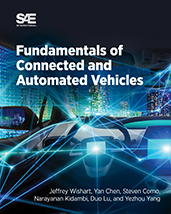Technical Paper
Micro-Mobility Vehicle Dynamics and Rider Kinematics during Electric Scooter Riding
2020-04-14
2020-01-0935
Micro-mobility is a fast-growing trend in the transportation industry with stand-up electric scooters (e-scooters) becoming increasingly popular in the United States. To date, there are over 350 ride-share e-scooter programs in the United States. As this popularity increases, so does the need to understand the performance capabilities of these vehicles and the associated operator kinematics. Scooter tip-over stability is characterized by the scooter geometry and controls and is maintained through operator inputs such as body position, interaction with the handlebars, and foot placement. In this study, testing was conducted using operators of varying sizes to document the capabilities and limitations of these e-scooters being introduced into the traffic ecosystem. A test course was designed to simulate an urban environment including sidewalk and on-road sections requiring common maneuvers (e.g., turning, stopping points, etc.) for repeatable, controlled data collection.

